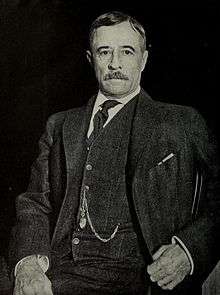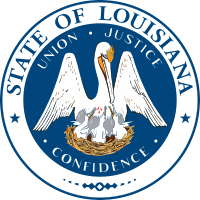John M. Parker
John Milliken Parker, Sr. (March 16, 1863 – May 20, 1939), was an American Democratic politician from Louisiana, who served as the state's 37th Governor from 1920 to 1924. He was a friend and admirer of U.S. President Theodore Roosevelt.
John Milliken Parker, Sr. | |
|---|---|
 | |
| 37th Governor of Louisiana | |
| In office May 11, 1920 – May 13, 1924 | |
| Lieutenant | Hewitt Bouanchaud Delos R. Johnson |
| Preceded by | Ruffin G. Pleasant |
| Succeeded by | Henry L. Fuqua |
| Personal details | |
| Born | John Milliken Parker March 16, 1863 Washington, Louisiana |
| Died | May 20, 1939 (aged 76) Pass Christian, Mississippi |
| Resting place | Metairie Cemetery |
| Political party | Progressive (1912–1916) Democratic (1916–1939) |
| Spouse(s) | Cecile Airey Parker |
| Alma mater | Eastman Business College |
| Occupation | Businessman |
Early years
Parker was born in Washington, a village in St. Landry Parish, in south central Louisiana. He was educated at the historic prep school Chamberlain-Hunt Academy in Port Gibson, Mississippi, Belle View Academy, and Eastman Business College in Poughkeepsie, New York. A prominent businessman, he was the president of the New Orleans Cotton Exchange and the Board of Trade.
In 1891, Parker participated in the mob that lynched eleven Italian immigrants in New Orleans, avenging the murder of Police Chief David C. Hennessy. He refused to apologize for his role because he believed the mass lynching was justified.[1]
Parker the Progressive
Parker first ran for governor in 1916 as the nominee of Roosevelt's 1912 Progressive Party and polled 37.2 percent of the vote against the Democratic choice, Ruffin Golson Pleasant of Shreveport. Later in 1916, the national Progressive Party chose Parker as its candidate for vice president, but Roosevelt returned to the GOP fold and endorsed Charles Evans Hughes for president. The Democrats Woodrow Wilson and Thomas Marshall were nevertheless reelected to the presidency and vice presidency. Four years later, Parker returned to the Democratic fold, considered an essential move to win a Louisiana election at the time, and was elected governor with former opponent Pleasant's support. Louisiana governors were then term-limited after a single four-year term but could seek second terms after sitting out four years.
Parker's record as governor
As governor, Parker was known for his interest in building gravel roads in rural areas. There were few paved highways at the time in Louisiana.
Parker advocated increased oil and gas severance taxes to finance public education. Huey Pierce Long, Jr., criticized Parker's tax plan as "too little" for the state's needs. Parker also opposed the New Orleans political machine.
Like Roosevelt, Parker was a staunch conservationist of natural resources and the environment. And he was sceptical of large business combinations that tended to become monopolies.
Parker led the move to draw up the Louisiana Constitution of 1921. He also pushed for the relocation of Louisiana State University from the downtown to the southern part of Baton Rouge. His old rival Huey Long later tried to mold LSU into the Long mystique.
Parker failed to increase educational funding to the level desired and to expand state civil service protection. He often found that his fiscal conservatism was in conflict with his progressive spirit.
In 1922, Governor Parker sent the Federal Bureau of Investigation a message begging for help in fighting the Ku Klux Klan, which had grown so powerful in Louisiana that it not only controlled the northern half of the state but had kidnapped, tortured, and killed two people who opposed it.[2]
Parker commuted the death sentences of two African Americans, Chester Tyson and Mark Peters, convicted in a notorious murder case in the community of Grove in Webster Parish in northwestern Louisiana. On Christmas Day 1916, the family of John Nelson Reeves, including his wife Maude and three of their four children, was bludgeoned to death by a group of axe-wielding men. The presumed motive for the killing was money that Reeves, who distrusted banks, had boasted of having stashed away in a mattress in his house. The prosecutor in the case, Harmon Caldwell Drew of Minden, had been on the job for less than a month when the crime occurred. The district judge in the case was John N. Sandlin, later a U.S. representative and like Drew an occasional intraparty opponent of the Longs from Minden.[3]
A petition sent to the Louisiana Board of Pardons claimed that two white men, Henry Waller and Johnie Long, had actually planned and carried out the crime but had each received life sentences, rather than the death penalty. Governor Parker, on Sandlin's recommendation, commuted the sentences of Tyson and Peters to twenty years, and they were released in 1936. Parker blamed the confusion over the case on his predecessor, Governor Pleasant, for having hesitated in carrying out the initial sentence of hanging.[4]
Post-gubernatorial years
After his gubernatorial term ended, Parker devoted himself to his experimental farm at Bayou Sara near St. Francisville in West Feliciana Parish. In June 1929, he was named president of the Constitutional League of Louisiana, which was organized at the St. Charles Hotel in New Orleans to "save the state from Huey Long". State Senator Norris C. Williamson of East Carroll Parish became the vice-president of the 300-member group.[5] Two other former governors, Jared Y. Sanders, Sr., and Ruffin Pleasant also spoke out against the Long political organization.
Parker died in 1939 at the age of seventy-six in Pass Christian, Mississippi, east of New Orleans. He is interred at Metairie Cemetery in New Orleans.
The 12,000-seat John M. Parker Agricultural Coliseum on the LSU campus is named in his honor.
World War I
Roosevelt selected Parker as one of eighteen officers (others included: Seth Bullock, Frederick Russell Burnham, and James Rudolph Garfield) to raise a volunteer infantry division, Roosevelt's World War I volunteers, for service in France in 1917. The U.S. Congress gave Roosevelt the authority to raise up to four divisions similar to the Rough Riders of 1st United States Volunteer Cavalry Regiment and to the British Army 25th (Frontiersmen) Battalion, Royal Fusiliers; however, as Commander-in-chief, U.S. President Woodrow Wilson refused to make use of the volunteers, and the unit hence disbanded.[6]
References
- Bennett H. Wall, "Louisiana: A History", (Harlan Davidson, Inc., 2008), pp. 268
- Federal Bureau of Investigation – Press Room – Headline Archives Archived September 19, 2009, at the Wayback Machine at www.fbi.gov
- Marilyn Miller, Sons of Darkness Sons of Light (Many, Louisiana: Sweet Dreams Publishing Co., 2000), pp. Foreword, 1–4, ISBN 1-893693-09-0
- Miller, Sons of Darkness Sons of Light, pp. 187–188
- Huey P. Long, Jr., Every Man a King: The Autobiography of Huey P. Long (New Orleans: National Book Club, Inc., 1933), p. 183.
- Roosevelt, Theodore (1917). The Foes of Our Own Household. New York: George H. Doran company. p. 347. LCCN 17025965.
External links
- Cemetery Memorial by La-Cemeteries
- John M. Parker at Find a Grave
- John M. Parker Papers at The Historic New Orleans Collection
| Party political offices | ||
|---|---|---|
| Preceded by None |
Progressive nominee for Governor of Louisiana 1916 |
Succeeded by None |
| Preceded by Ruffin G. Pleasant |
Democratic nominee for Governor of Louisiana 1920 |
Succeeded by Henry L. Fuqua |
| Political offices | ||
| Preceded by Ruffin G. Pleasant |
Governor of Louisiana May 11, 1920–May 13, 1924 |
Succeeded by Henry L. Fuqua |
